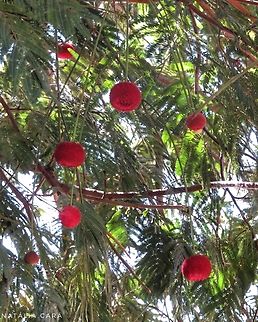
Appearance
"Parkia pendula" trees range from 15 to 50 meters in height and can be up to 1.2 meters in diameter. The bark is either whitish-grey or reddish-brown and plated, with many lenticels. The strong, fruity aroma of a blooming "Parkia pendula" can be attributed to monoterpenes in the flower, specifically the stereoisomers ????-ocimene and ????-ocimene.Unlike other "Parkia" species, "Parkia pendula" has a flattened and layered crown of leaves. The horizontal branches support alternating bipinnate leaves that come in about 15 to 27 pairs, narrowing to a maximum of 3 leaves whorled about a node. The leaves themselves are dark green and oblong, with curved distal ends.
Distribution
"Parkia pendula" can be found in a variety of countries, mainly Bolivia, Brazil, Colombia, Costa Rica, French Guiana, Guyana, Honduras, Nicaragua, Peru, Suriname, and Venezuela. It grows in many lowland forests, with a large reserve found in a national park in Espirito Santo, BrazilHabitat
An adult tree is very flood tolerant, capable of withstanding long-term submersion. Despite this, early seedlings can only survive a few weeks in flooded conditions, limiting the range of environments "Parkia pendula" can thrive in.Reproduction
The "Parkia pendula" tree exhibits mass flowering, typically with 150 to 200 capitula blooming in one night. The flowers open sequentially from the base to the tip. The capitula appear bright red due to the color of the anthers and filaments, then become yellow-red at dusk when nectar and pollen are produced. When the styles elongate, the plant takes on a purple-red hue, finishing the dramatic color shift all within one night. Flowers are usually shed afterwards within a span of 3 to 4 days.Predators
Insects, specifically certain species of beetles, deposit eggs inside the bud of "Parkia pendula", acting as a parasite on the seeds. Despite this, there is no considerable impact on the persistence of the species and the IUCN lists it as a species of Least Concern.
Uses
The wood from "Parkia pendula" is moderately heavy, with a density of 0.57 g/cm3. Processed wood typically has a white or yellow color, with a thick textured grain. It is resistant to fungal infections, but porous enough for preservatives, so it is commonly used in furniture and carpentry.Due to its high growth rate and capability to attract wild animals while fixing copious amounts of nitrogen, "Parkia pendula" is perfectly suited to afforestation. It can be planted in degraded, barren environments and serve as a dependable foundation for establishing a forest.
The seed pod gum is also notably used to catch birds.
References:
Some text fragments are auto parsed from Wikipedia.